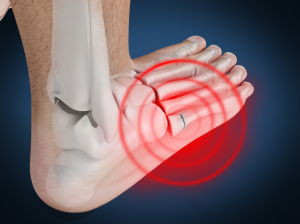
 While a regular fracture describes a break in the bone that tends to occur suddenly, and a stress fracture describes tiny hairline cracks that develop slowly over time, an avulsion fracture is one where the stress and tension from a tendon or ligament that is attached to a bone pulls of a piece off the bone, fracturing it.
While a regular fracture describes a break in the bone that tends to occur suddenly, and a stress fracture describes tiny hairline cracks that develop slowly over time, an avulsion fracture is one where the stress and tension from a tendon or ligament that is attached to a bone pulls of a piece off the bone, fracturing it.
One of the most common sites for an avulsion fracture is at the base of your fifth metatarsal – the long bone in the midfoot that connects to your fifth toe. If you run your fingers along the outside edge of your foot, you’ll be able to feel a bump called the styloid process. This is where the fracture occurs. As this region has a poorer blood supply than other areas of the foot, this means healing and repair can be lengthy and painful.
Who Is At Risk Of An Avulsion Fracture And Why?
While anyone can sustain this fracture through accidentally twisting the foot, like during an ankle sprain or a misstep on the ground or curb, you may have a higher risk if you are prone to overusing a muscle that runs down the outside of your leg and attaches to the styloid process called the peroneus brevis. When this muscle is tight and repetitively pulls at its attachment, the fracture is most likely to occur. We most often see this fracture in dancers, especially in ballet due to the time spent on the toes.
Symptoms can include pain on the outside border of the foot that can radiate up the outside of the foot and leg, swelling, bruising, and difficulty walking and wearing shoes without significant pain.
Treating An Avulsion Fracture
 First steps
First steps
If your pain has just started, the best place to start is to rest, elevate your foot, apply ice to help reduce the swelling, and use a compression bandage if you have one. Non-steroidal anti-inflammatory medications like Nurofen can also help with the swelling and pain.
See your podiatrist
Next, you need to see your podiatrist immediately. As we mentioned earlier, these fractures take longer to heal due to their location, so effective treatment from the get-go is very important. Depending on your symptoms, we may recommend a moonboot or other walker, custom foot orthotics that alleviate pressure and pain away from the outside border of the foot and the fracture site, adjust the shoes you wear daily to help best support your recovery, and adjust your regular activity plan. No physical therapy should be started until significant healing and repair has occurred.
Surgery
In some cases, depending on the severity of your injury, surgery may be an option. If this is the case, we will refer you appropriately.
Healing and return to activity can take anywhere between six weeks to four months, or longer if complications arise.


